Articles on Animation 10 Apr 2010 07:48 am
Animation in the USSR
The following is an article ripped from the pages of ANIMAFILM #1, 1979. This is definitely dated since the walls fell, the Recession hit and none of these companies exist anymore. However, it’s always good to cover a snapshot of history.
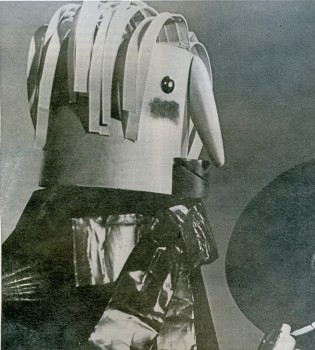 Animated film is a welcome guest everywhere. It fills people with joy and expectations. It is a cathartic and rejuvenating agent. Its magic holds people of all ages spellbound. The Home Committee for the Art of Animation, meeting in a plenary session in Kishinev, has deliberated upon Soviet animated film-making as an international art. Prominent Soviet artists, who have laid down the foundations for domestic animated film production, animators of international repute as well as young newcomers to the art, have thoroughly and seriously discussed the further possibilities for developing animated film.
Animated film is a welcome guest everywhere. It fills people with joy and expectations. It is a cathartic and rejuvenating agent. Its magic holds people of all ages spellbound. The Home Committee for the Art of Animation, meeting in a plenary session in Kishinev, has deliberated upon Soviet animated film-making as an international art. Prominent Soviet artists, who have laid down the foundations for domestic animated film production, animators of international repute as well as young newcomers to the art, have thoroughly and seriously discussed the further possibilities for developing animated film.
Gaydar’s little boy an Rudyard Kipling’s Mowgli, Charles Perrault’s
Cinderella and Little Red Riding
The Sauna, by Sergei Jutkievich, Anatoli Karanovich ____Hood, Alexei Tolstoy’s Buratino,
_______________________________________________and Ilya Muromets – the protagonist of the “hillins” (fables). Pushkin’s Duke Gwidon and the czar’s daughter-turned-swan by magic, Yershov’s Hunchbacked Pony, or Samuel Marshak’s and Korney Chukovsky’s enchanted animals – are the dearest friends from our childhood days. Animator’s hands and imagination have breathed new life into literary characters, making them available to young audience even before they can write and read. Actually, such encounters are for young viewers their first ineffaceable lesson in beauty, as well as a school of character because the stories deal with friendship, valiancc, goodness and justice. This is what the tremendous, inimitable value of animated film consists in. “Animated films cannot be compared to anything else”, said the great Soviet animator. F. Khitruk. at the Kishinev session.
Two-thirds of the animated film production in the Soviet is addressed to children. But adults value animated films equally highly. Its form makes this branch of art an ideal go-between linking adults and children. It is characterized by a variety of subjects, and a richness of styles, genres and ideas. The animated film industry is now developing in every Soviet republic.
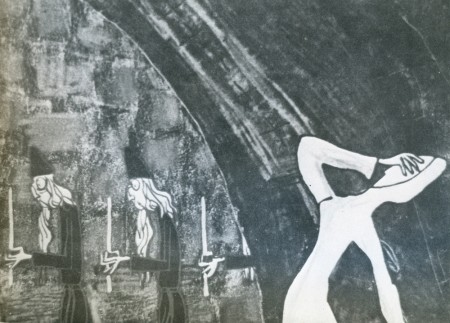
Film, film, film, by Fedor Khitruk
The production of twenty-two republican film studios was reviewed in Kishinev. The Chairman of the Home Committee for Animation, B. Stepantsev, who holds the title of the Merited Artist of the Russian Socialist Soviet Republic, pointed to the very important fact that young film makers in Georgia, Kazakhstan, the Ukraine and Estonia have become widely known for their courageous study of current customs, morals and philosophical problems. This group of artists derives inspiration from native folklore and everyday events. Another notable group is the animators from Moldavia who are busy searching for unconventional forms of artistic expression.
The Kishinev session has shown thai the Soviet art of animation is expanding vigorously. (ATEM)
The distribution of short animated films, as other films not quite fitting the established standards of distribution, encounters problems. However, over the past 10 years the Soviet’s movie industry and distribution workers, cooperating closely with civic organizations and animated films popular both with children and adults.
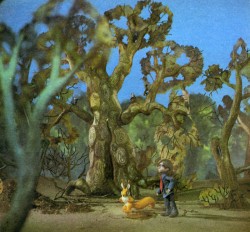
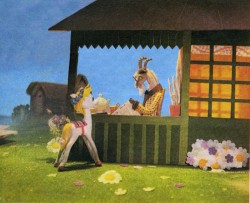
(Left) Farewell, Green Forest, by Michai! Kamenetski
(Right) One While Horse, by Vladimir Danilovich
The Soviet animated film studios annually turn out about 80 short films for children of different ages, not counting the films commissioned by various organizations, and didactic and advertising films. Every year the Soviet distribution network channels to viewers about 60 new animated films made in the USSR and about 20 such films made in socialist countries. On top of this the movie theatres have at their disposal about 500 archival films. Altogether, they avail themselves of a repertory of over 600 animated films, and that number is on a steady rise. Between 600 and 1000 copies of every film are made, some of them being reproduced on 16-mm tape for screening in schools and by travelling movie theatres.
.
There are various forms of film distribution, the most popular of them being feature-length package programmes. Sometimes such programmes exceed the standard length when a feature film is preceded by several, rather than one, short animated films. All in all, the package programmes are categorized into those addressed to children and (hose addressed to adults. Children’s programmes are mostly shown in special children’s cinemas (of which there are 300 at present) and during morning film sessions in standard cinemas on Sundays and holidays.
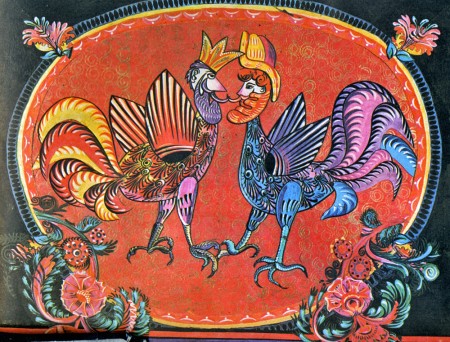
Gilt on Their Foreheads, by Nikolai Sercbrakov
Animated films tor adults chiefly accompany evening feature length film sessions or are shown in special short-films-only cinemas, of which there are over 200.
There also are four cinemas in Moscow which are exclusively used lo show animated films. Their combined capacity is 1.200 seats.
The methods of popularizing animated films are multifarious. For example, there are animated-film lovers’ societies attached to movie theatres attended by both adults and children.
The societies organize film shows to which they invite both domestic and foreign film animators and directors. Soviet audiences have already met with such animated film celebrities as Todor Dinov, Popescu-Gopo, Paul Grimault, Nedelko Dragic, Otto Koky, Stefan Janik and many others. Regular displays of works by the animators from the “Soyuzmultfilm” studio, and of children’s drawings, are held in cinema foyers. Every year animated film theatres have a turnout of 1,500 000 viewers.
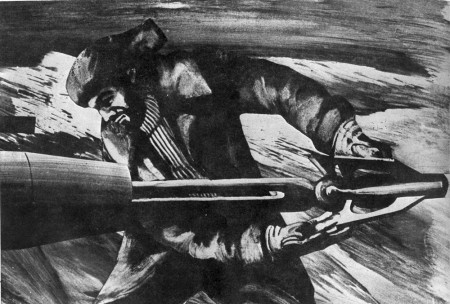
The Spear, by Rein Raamat
Soviet film-makers lake an active part in popularizing the animated film art. The most effective means they employ are the folk festivals organized in the individual republics, regions and districts with the help of the USSR Film-makers’ Association and film distributors. The festivals provide abroad forum for presenting the top achievements of Soviet animated film in cities, towns, and villages. The events are widely advertised and covered by the local press, radio and television networks. Special documentaries on the films shown, stories about the film-makers and interviews with the participants are regular items attendant on the festivals. The “Soyuzmultfilm” studio has already organized folk festivals in Western and Eastern Siberia, in the Caucasus and northern regions, the Far East and Central Asia. Artists from the “Kievnautchnyifilm” (educational film studio), which has an animation branch, take part in the festivals held in Ukraine. Also film-makers from Estonia keep in close touch with audiences. The folk festival in Moldavia marking the 40th anniversary of “Soyuzmultfilm” was a resounding success. Over 120 meetings between animators and audiences took place in the republic’s capital, Kishinev. Undeniably, the folk festivals stir popular interest in animated-film production and enlarge the scope of its influence.
The publishing house of the V/O “Soyuzingormkino” enterprise regularly brings out advertising and informative material on animated films meant for local film distrihutors and advertising and information centres.
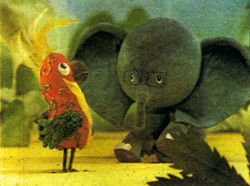
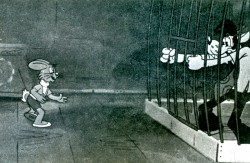
(Left) Where Is Baby Elephant Going, by Ivan Ufimccv
(right) Wait a Bit, by Vyacheslav Kotenochkin
Animated films are regular fixtures in central and regional television broadcasts. Every month the television networks in the Ukaraine and Georgia sponsor special broadcasts entitled the “Animated Films Panorama” and introduced hy the well-known animated film directors, Yevgeny Sivokon and Vachtag Bahtadze.
N. Venzher
This article gives me the opportunity of repeating a short anecdote on this blog.
It was 1977, and I was working at Raggedy Ann & Andy for Richard Williams. I was the head of Assistant Animators and Inbetweeners. A friend of mine who worked for an agency that supervised tours of Russian artists around the US, gave me a phone call. He was in NY with a pair of Russian animators who couldn’t speak a word of English, and he promised them that he’d try to get them into a NY animation studio. Could I do this on a Saturday?
I asked Richard Williams, and he said ABSOLUTELY NOT! (He was so violently against it, I could almost imagine that he’d had a bad experience in the past.) I called Faith Hubley (John was in England at the time working on Watership Down.) She and the studio were unavailable. The best I could do was to contact Howard Beckerman – in the same building as Raggedy Ann.
Howard had a one-man studio in NY, and had two small rooms and a couple of cubicles with lots of cel paint bottles coloring the space.
The two animators, who I met for the first time, were Rein Raamat and Vyacheslav Kotenochkin. I spoke poor to little Russian, with my friend, Richard Mayer, interpreting most of the conversation. We had a nice talk in their hotel room, went for a light breakfast and visited Howard, who was incredibly gracious and kind.
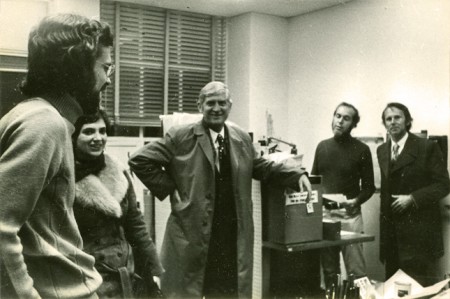
(L to R) Richard Mayer, Maxine Fisher, Vyacheslav Kotenochkin,
Howard Beckerman and Rein Raamat
Afterward, I offered to take them wherever they wanted to go in the City. I had my car.
Vyacheslav Kotenochkin wanted to go to “Yablokov Street”. I didn’t need a translator to figure out that that meant “Apple” street. I did need help to realize that he meant “Orchard” Street. “Yablokov” was the name of a storeowner on the street. I took them down to lower Manhattan to go shopping at these turn-of-the century type shops. Kotenochkin bought a dozen pair of jeans for his friends and a bunch of other things including a multi-colored clown-like wig. Rein Raamat just enjoyed watching.
When we were back midtown, Vyacheslav Kotenochkin left us for his hotel, and Rein Raamat wanted to see a Modigliani painting in the Museum of Modern Art. That was his favorite artist, at the time, and he’d never seen one in person. This part was easy. I was a member and got him in for free. When we turned the corner and this great big nude by Modigliani appeared Raamat gasped. A tear came into his eye, and the day was sunk in my memory as a key one.
For years after that, Rein Raamat exchanged letters and books. I’d sent him a large book on Modigliani and he sent me a German book on Bosch. We were able to write to each other in Russian. He didn’t speak it well, at the time, neither did I. Two people writing and reading pigeon-Russian seemed appropriate as a way of communicating.
Unfortunately, we haven’t spoken, nor have we written in a number of years. Though we have infrequently met up at some film festivals. Life’s like that some times.
See this post, to view some photos of the day.

on 10 Apr 2010 at 9:47 am 1.richard o'connor said …
Beautiful story.
Not only is “life like that” -that IS life.
on 10 Apr 2010 at 9:35 pm 2.Niffiwan said …
Thank you very much for transcribing this fascinating article! And a fascinating story, too. I’m sad to hear that Richard Williams was prejudiced against Russian animation artists. I don’t know what he was expecting them to do…
Of the studios mentioned here, a number still exist, at least renamed and very poorly-funded.
Would you mind if I re-post this on my own blog, as well?
P.S. “Nikolai Sercbrakov” is “Nikolai Serebriakov” or “Nikolay Serebryakov”. “Ivan Ufimccv” is “Ivan Ufimtsev”
on 11 Apr 2010 at 7:57 am 3.Michael said …
Niffiwan, Please feel free to post this on your blog. I have the Russian version, if you’d like it.
on 12 Apr 2010 at 12:54 am 4.Niffiwan said …
Thank you, Michael.
It would be fantastic if you could upload the Russian version somewhere. Though I don’t ask for my own benefit; I’ve gotten a few messages from alek_morse (Alexander Sedov), who wants to translate this article into Russian for his readers. If there’s a Russian version of it, this would of course make it much easier for him.
on 12 Apr 2010 at 7:01 am 5.Alexey Kobelev said …
Dear Michael!
I’m afraid you have misspelled Kotenochkin’s name. His name was Vyacheslav. You’ll find more info about Mr.Kotenochkin here: http://animator.ru/db/?ver=eng&p=show_person&pid=1062
Best regards!
on 12 Apr 2010 at 8:07 am 6.Michael said …
I took his name and the spelling from the article in ANIMAFILM. They include it in the article as “Vladimir” both in English and in Russian.
Sorry that I got it wrong, and thank you for correcting it.
I’ve doubled back in the article and have corrected it there. Thanks.
on 12 Apr 2010 at 9:29 pm 7.Niffiwan said …
Thanks Michael. I hope you get a chance to scan the Russian article soon.
By the way, a bit of a funny side note… I directed someone to this article and he replied “I was afraid to click on that link for a moment; somehow ‘Michael’s Porn Animation’ didn’t seem to complement either the post or the topic.” Yikes! Never noticed that before…
on 13 Apr 2010 at 1:52 am 8.Niffiwan said …
Ok, reposted (with some spelling corrections and links): http://niffiwan.livejournal.com/30683.html?mode=reply
Michael, was this sentence maybe copied down incorrectly? It seems like there might be a word missing… “However, over the past 10 years the Soviet’s movie industry and distribution workers, cooperating closely with civic organizations and animated films popular both with children and adults.”
on 06 Apr 2011 at 3:31 pm 9.Cartoonist said …
Amazing post, truly!
http://cartoon-artist.blogspot.com/